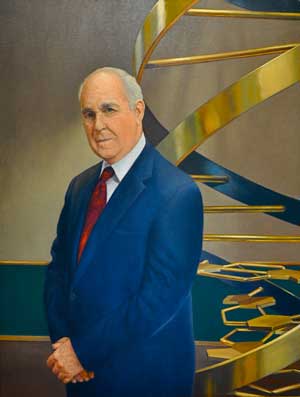
Waclaw Szybalski Lecture Series honors the over 60 years of close ties between Cold Spring Harbor Laboratory and Dr. Waclaw Szybalski, a pioneering geneticist, microbiologist, cancer biologist, and genome scientist.
Szybalski’s research career began at Cold Spring Harbor in 1951 after his emigration from Poland. Here he invented the gradient plate technique—a method for isolating drug-resistant mutants and determining the minimal inhibitory concentration of antimicrobial compounds. He also performed genetic studies of cross-resistance to antibiotics and mutation rates that led to the idea of “multiple antibiotic therapy.” In 1954, Szybalski moved to the new Institute of Microbiology at Rutgers University and then in 1960 to the McArdle Laboratory for Cancer Research at the University of Wisconsin Medical School in Madison, Wisconsin, where he remained for the rest of his research career. There he discovered the radiosensitization of human and bacterial cells by incorporation of 5-bromo- and 5-iododeoxyuridine into their DNA, a discovery that had a very practical application in enhancing radiotherapy of cancers. Also among his many research achievements was the first enzymatic synthesis of biologically active DNA in 1963 with Rose Litman. His later work focused on the function of regulatory elements, sequencing methods, and genome science.
Szybalski met the physicist and phage biologist Max Delbrück during his early days at Cold Spring Harbor and has the rare distinction of attending every CSHL Phage meeting from its inception in 1950 through the last meeting 2010. Szybalski was also a regular participant in the CSHL Symposium on Quantitative Biology.
Because his first lab desk at CSHL was in the Carnegie Building, Szybalski had a special affection for this building. At the 2001 and 2002 Phage meetings, Szybalski urged the Lab to add an annex to the Carnegie Library that would include meeting space and space for visiting researchers, and he provided a generous philanthropic donation to make this possible. The result was the Szybalski Annex, which opened in 2010, and houses the Szybalski Reading Room. Dr. Szybalski’s portrait hangs in the Reading Room, which also contains a large-format illustrated volume detailing his life, his scientific achievements, and his many honors.
Lectures
| 2018 | “Barbara McClintock, Nobel Laureate and America’s Most Distinguished Cytogeneticist.” (Date to be announced) |
| 2017 | “Neurosurgery before Neurosurgery: The Formative Years 1517-1867.” Lecture: Dr. Eugene S. Flamm, Neurosurgeon and Rare Book Collector, Albert Einstein School of Medicine |
| 2016 | “What can Cold Spring Harbor Laboratory Tell us About Women’s participation in Science.” Lecture: Dr. Marsha Richmond, Wayne State University |
| 2015 | “The Genetic Legacy of H.J. Muller: Nobel Laureate, Geneticist, and Social Scientific Activist” Lecture & Panel Discussion: Elof Carlson, Indiana University, Visiting Scholar Institute For Advanced Study, Emeritus, James Schwartz, Helen Muller, professor emerita at the University of New Mexico |
| 2014 | “100 Years on Alfred Russell Wallace, Charles Darwin and the Discovery of the Theory of Evolution by Natural Selection.” Lecture by Andrew Berry, Harvard University |
| 2013 | “Two sides of Rachmaninoff,” Concert/Discussion | 2012 | “Writers and Original Sources.” Lecture & Panel Discussion: JD Watson, S. Brenner, R. Olby |
| 2011 | “Historic Milestones of Cold Spring Harbor Laboratory.” Speaker: Mila Pollock, CSHL |